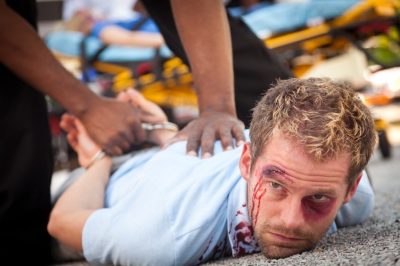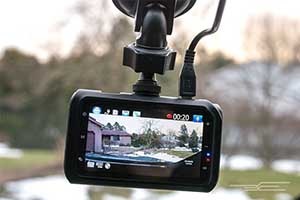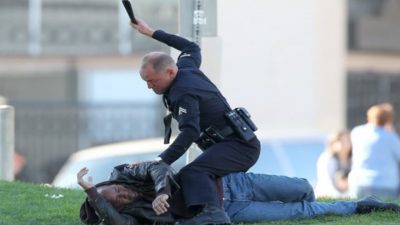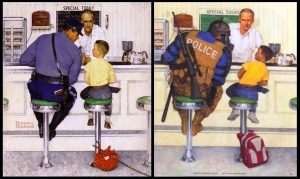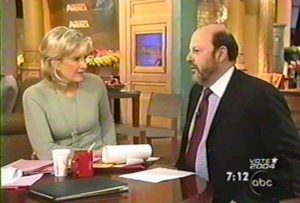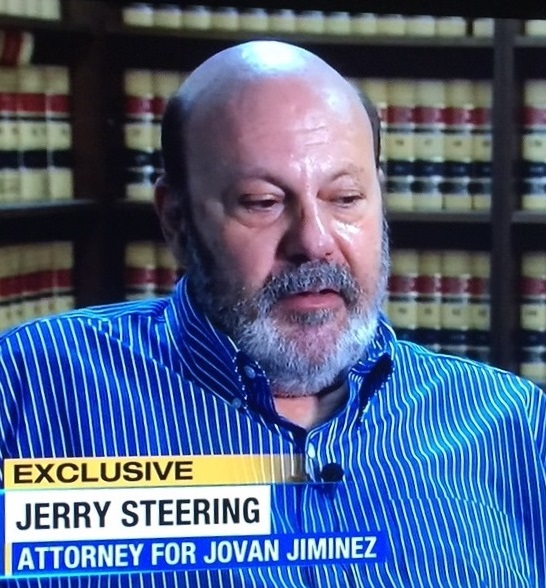
Jerry L. Steering is an expert in and has prosecuted, defended, consulted or has otherwise been involved in hundreds of cases, and righteous civil rights civil actions. He has sued states, municipal entities (i.e. cities and counties) and even the United States government.
We now live in a time of great importance; a time where we are going to be called upon to decide what type of government we want; these days, whether or not we shift from a free society into a “police state”. These “Contempt Of Cop“ cases are those on the front lines of that never ending battle between the oppressed (the beaten / violated ones; the victims of bruised frail police egos), and their oppressors (the police.) Never before in the history of the Republic, has our commitment, to the sovereignty of, and respect for, the rights of the individual, been so much in ignored, and some much in doubt.
With each passing case, bit by bit, bite by bite, by the “Opinions” of the United States Supreme Court, the United States Courts of Appeals, and the state appellate courts, we see our basic right to be left alone, and our right not to be exposed to unreasonable searches and seizures, either vanish completely or yield to claims by police officers that the constitutional balance of their safety versus your constitutional rights by tipped in their favor.
Unfortunately, the natural American’s reaction to hearing that you are accused of a crime, is to presume that you actually committed some crime, or otherwise acted unlawfully, anti-socially, dishonorably or despicably. That you are the bad guy. That you crossed some known barrier, that separates good, moral and reasonable conduct, and acted contrary to the social contract; that you acted unreasonably and immorally.
That is the stigma that you now bear. No matter what you do, no matter what happens to your cause, the fact of your arrest by the police, places you in a different category in the minds of all of us; to one degree or another. You may win millions of dollars for what the government has done to you, but you will, in perpetuity, have an arrest record, notwithstanding any lack of criminal or even unreasonable conduct by you.
Don’t get too exited about an expungement of you misdemeanor conviction pursuant to Cal. Penal Code § 1203.4 (California expungement of misdemeanor conviction statute.)
 Notwithstanding anything that you are told by your cousin or pals, or even a judge or lawyer, nothing in the language of Section 1203.4 actually states that you may withhold the fact of your now expunged conviction, from another.
Notwithstanding anything that you are told by your cousin or pals, or even a judge or lawyer, nothing in the language of Section 1203.4 actually states that you may withhold the fact of your now expunged conviction, from another.
So, for example, if you get your misdemeanor conviction expunged pursuant to Cal. Penal Code § 1203.4 , you still have to divulge the conviction when applying for employment with a government agency, or for any sort of government licensure. Moreover, these convictions now live in private databases that one can find online within seconds (just Google criminal background checks, and see how many avenues of obtaining that information exist; instantly.) Also, if you sue for false arrest or for unreasonable force, when you fill-out that job application, and question 6 asks for your arrests (to which, pursuant to Section 1203.4 you answer “No”), how are you going to answer question number 7; have you ever been a party to a lawsuit. If “Yes”, please explain? Are you going to say in question 6 that you’ve never been arrested, and then in question 7, state that you sued another for false arrest?
Vindication is our goal, for our unfortunate criminal defendant / civil plaintiff clients, who are truly innocent, and who are accused of a “crime against justice.” There are a lot more innocents of “Contempt Of Cop” crimes, than just about any other type of crime. That’s because the victim is the one being gooned, arrested and prosecuted. These “Contempt Of Cop” cases, both civil and criminal, are the majority of Mr. Steering’s law practice. Here are a few tips for such innocents being wrongfully criminally prosecuted.
“Contempt Of Cop“ cases, are bogus criminal actions, brought against innocents by criminal prosecutors, for essentially, “bruised ego” violations. The “ego bruising”, is really nothing more than a civilian not immediately, and without protest or question, getting-down on the ground in a prone position, or not doing something that the officer wants you to do (lawful, reasonable or not) immediately, and without question or protest.
The Constable’s “ego” is typically “bruised”, by your conduct, such as: 1) asserting your Constitutional rights , or 2) claiming knowledge of them, or 3) asking the Constable why you’re being ordered to lie down on the ground while your chest is being illuminated by the red spot of a pistol or rifle targeting device; 4) telling the Constable that you have a medical condition that makes it difficult or painful to get on the ground; 5) telling the Constable that he can’t do something (i.e. can’t go in my house without a warrant); 6) failing to consent to an entry or a search; 7) not exiting your house when ordered to do so (even though the police generally can’t order you to exit; U.S. v. Al-Azzawy, 784 F.2d 890 (1985), and 8) video / audio recording the police [something lawful].) These are but a few examples. The list is endless, but the theme is the same.
Failing to immediately do whatever the police tell you to do, without protest, challenge or remarks, often will result in you being beaten-up, falsely arrested, and maliciously criminally prosecuted; and, in places with “conservative jurors”, convicted for resisting arrest and battery on a peace officer. This is no joke. The overwhelming majority of “Contempt of Cop” criminal prosecutions are simply bogus. The police usually accused persons of fairly innocuous, but nonetheless, criminal conduct. Criminal, again, in the sense of a failure to immediately, and without question, do whatever the police tell you to do. That is a police state, if the police can brutalize and falsely arrest you, and you plead to time served and community service, just because the contrived charges have resulted in unobtainable bails; bail amounts that keep you in jail.
These,“Contempt Of Cop“cases, typically involve the police using force upon persons (i.e. beating them) and/or falsely arresting them, and then inventing bogus and “creative” allegations of violations various “Contempt Of Cop” statutes, such as violations of: 1) Cal. Penal Code § 148(a)(1) (resisting / obstructing / delaying peace officer; the most abused statute in the Penal Code); 2) Cal. Penal Code § 240/241(c)(assault on a peace officer); 3) Cal. Penal Code§ 242 / 243(b) (battery on a peace officer); and 4) Cal. Penal Code § 69 (interfering with public officer via actual or threatened use of force or violence.) Cal. Penal Code § 69 is a “wobbler”; a California public offense that may be filed by the District Attorney’s Office as either a felony or a misdemeanor. In Orange County, Riverside County and Los Angeles County, allegations of violation of Cal. Penal Code § 69 are usually filed as misdemeanors. In San Bernardino County, however, allegations of violation of Cal. Penal Code § 69 are filed as felonies much more often than her sister counties.
As shown below the ambiguity of California’s “Contempt of Cop” statute, Cal. Penal Code § 148(a)(1), “allows” the police to claim to that you committed a crime for behavior that is constitutionally protected, such as verbally protesting police action (i.e. “officer, stop hitting that handcuffed man in his head”), questioning police assertions of authority (i.e. “Do you have a search warrant to have entered and searched my house“) and failing to immediately comply with orders from a police officer (i.e. “Officer; why are you pointing that gun a my face and want me to lie down on the dirty ground”.)
It’s also the general default charge that the police use when you didn’t commit a crime, because the boys and girls back at the at the station in the report writing room, will come-up with some sort fabrication of the events, based on the “deniable” and the “undeniable”, to justify splitting you head open for not getting on the ground fast enough. The police Admit but spin what they can’t deny (i.e. conclusive video or audio recording), and deny anything prejudicial, or any material fact that is viewed as potentially helpful to the victim of police abuse being able to recover compensation for outrages perpetrated upon them.

A recent example of the ignorance about and misuse of Cal. Penal Code § 148(a)(1) is the arrest of actress Daniele Watts in Los Angeles by the LAPD. The LAPD received a call that a man and a woman were getting it on in a car in Los Angeles. When they arrived at the scene they saw Daniel Watts and her boyfriend, but they weren’t doing anything. The LAPD Officer started his investigation for a possible case of lewd conduct in public (Cal. Penal Code § 647(a)) and asked Ms. Watts for her name. She refused to tell the officer her name, claiming that she had a right not to do so. Notwithstanding the fact that Ms. Watt’s claim was correct, the LAPD Officer told her that she had no such right and that she was obligated to divulge her identity to him (which is not the law.) Because of Ms. Watts’ refusal to identify herself, the LAPD Officer handcuffed her and placed her in the back seat of his patrol car (listen to recording here.) Throughout the contact, one can hear the officer repeat that he had “probable cause” (of some crime; which he didn’t), and that when the police are investigating a crime that a civilian has a duty to cooperate with the police including having to tell the police who they are, under the threat of arrest for non-compliance for Cal. Penal Code § 148(a)(1). The officer was wrong on both counts.
First, a person has no obligation to cooperate with a police investigation; especially of themselves. See, People v. Shelton, 60 Cal.2d 740 (1964) (“A suspect has no duty to cooperate with officers in securing evidence against him . . . “.) Second, since 1980 the California Courts have held that it is not a crime for a person to refuse to identify themselves to the police; even if they’re being lawful detained (save when they’re at the jail and are being booked) See, In re Chase C., Cal.App.4 (12/18/15); In re Gregory S.,112 Cal. App. 3d 764, 779(1980); People v. Quiroga, 16 Cal.App.4th 961 (1993); People v. Christopher, 137 Cal.App.4th 418 (2006); United States v. Christian, 356 F.3d 1103 (9th Cir. 2004); Martinelli v. City of Beaumont, 820 F.2d 1491 (9th Cir. 1987). So, while LAPD Chief Charlie Beck was on radio and television defending his officer’s arrest of Ms. Watts for refusing to divulge her name (See KCAL 9 TV Broadcast), he was encouraging other LAPD officers to commit crimes against civilians like the LAPD officer did against Ms. Watts when he cuffed her and placed her in his car for violation of Cal. Penal Code § 148(a)(1) for failing to identify herself. That’s a federal crime by the LAPD Officer; a violation of federal constitutional rights under color of authority; 18 U.S.C. § 242; a felony. Fear not, however, Chief Beck; the Los Angeles District Attorney’s Office has now come to your rescue. The California District Attorney’s Association and the California Department of Justice has even published guidance for California Peace Officers on this issue, and that guidance is that a failure to identify oneself to a peace officer is not a crime in California:
As things turned out, Ms. Watts was criminally prosecuted, but not for violation of Cal. Penal Code § 148(a)(1), but for misdemeanor public indecency. She ended-up pleading to the lowest charge in the Penal Code; misdemeanor disturbing the peace.
Mr. Steering has consulted on, or have represented clients, in thousands of these “Contempt of Cop”cases; both civil (suing the police and their employer) and criminal (defending bogus “contempt of cop” type cases.) Most of the police reports in these contempt of cop cases are cookie-cutter type reports. The officers use certain terminology in a way, that literally anything can be justified (i.e. a) the suspect’s hands were reaching for his waistband area, so I shot him; b) the suspect took an aggressive stance with fists clenched, so I tased him; or c) the suspect took an aggressive stance with fists clenched, so I punched him in the face, hip threw him on the ground, pulled him arms up behind his back and cuffed him; all with officer’s knee and body weight in neck of victim (“suspect”); d) the suspect said “f___k you to me, and took a swing at me; e) the suspect appeared to be impervious to pain, so I had to repeatedly hit him with my baton, which didn’t seem to have any affect on the suspect; f) my taser had no effect on the suspect so I hit him with my baton; and on, and on and on; and g) the suspect keep his hands underneath his body and wouldn’t allow me to pull his arms back, so I punched him in the head with hammer blows, and he gave up.
This B.S. goes on and on and on.) The politicians won’t take any action against the police, until they perceive that the body politic does, or foreseeable, will, or disapprove. So, for example, two Fullerton, California police officers were recently acquitted on murders charges for the beating death of Kelly Thomas; notwithstanding that the video and audio recordings of the beating death show two cops, threatening to, and then beating Kelly Thomas to death.
So, for example, according to Los Angeles County Sheriff’s Department statistics, in the year 2010, the LASD shot and killed 15 people who they claim were reaching for their waistband; none of whom were found to have had a weapon when they were shot.
Police Misconduct is rampant and condoned and defended by the command structure of most, if not all, modern police agencies. There is a “Blue Code of Silence“ between and among peace officers throughout the nation, and everyone knows this.
This is no startling revelation. The County of Los Angeles has itself released a report Commissioner by the Board of Supervisors, acknowledging the existence of, and actually condemning, the Sheriff’s Department’s own rogue gangs of sadistic jailers at the Los Angeles County Central Men’s Jail. See, The Citizens Commission on Jail Violence September 28, 2012.
A retired Los Angeles County Sheriff’s Department Captain reported to the Los Angeles Times, that the L.A. County Men’s Central Jail was, essentially, a torture chamber, run by these jailer gangs (tattoos of their gang symbols on their ankles and all) of sadistic sociopaths. Discipline for beatings was not existent, and torturing inmates was actually required for jailer gang initiation. See, “L.A. County sheriff’s official tells of jail brutality”, LA Times, July 7, 2012. See also, “L.A. County jail violence sheriff’s fault, panel says“, LA Times, September 28, 2012. Rival Sheriff’s Department jailer gangs even got into a rumble between the “3000 Boys” (the third floor jailers) and the “2000 Boys” (the second floor jailers)at a Sheriff’s Department Christmas party.
The Los Angeles Police Departments (LAPD’s) motto is: We’re the badest gang in town. A recent study of the Los Angeles Sheriffs Department (LASD) that was commissioned by the Los Angeles County Board of Supervisors (“Report of the Citizens Commission on Jail Violence“) actually found that there is a culture within the Los Angeles Sheriffs Department of various “gangs of officers”, who routinely beat, torture, maim and kill members of the jails, and of the community, for fun; for the honor of the gang. Everybody is a scumbag, and have no rights.
One of those gangs was “the Vikings”, whose “colors” was the Minnesota Vikings Football Team logo tattooed on their lower legs. The Former Undersheriff, Paul Tanaka, was a Viking gang member when he was a Captain at the Lynwood Sheriff’s Station. The Vikings were found by United States District Judge Jesse Curits to be a Neo-Nazi / White Supremacist gang within the ranks of the Los Angles County Sheriff’s Department; See, Thomas v. County of Los Angeles, et al; 978 F.2d 504 (1992).
Some of the LASD gangs of these gangster deputies are: The 3000 Club (the deputies who worked the third floor of the L.A. County Men’s Central Jail), The Grim Reapers, The Little Devils, The Regulators, The Vikings and The Jump Out Boys. After the FBI had announced that it had infiltrated the Los Angeles County jail and can now prove that the LASD Men’s Jail was essentially a torture chamber, with gangs of sick and sadistic guards, Paul Tanaka still showed his grit, as an LASD “gansta”, by addressing the command staff of the sheriff’s department, about the LASD internal affairs bureau. He mentioned that their were 45 LASD Internal Affairs Bureau investigators, and that was 44 too many (you’re got to have at least one to have a bureau.)
In 2014, six LASD Deputy Sheriffs were convicted of obstructing the FBI’s investigation of the torturing of prisoners at the Los Angeles County Jails. That’s not the end of it. Former LASD Deputy Sheriff Noel Womack pleaded guilty in June of 2015 to federal charges of lying to the FBI about systemic LASD torturing and framing of inmates at the Los Angeles County Jails.
One might think, why are these cops acting like Nazis; literally, not metaphorically? Why is this allowed to persist? Things have gotten so bad at the LASD that now the United States Department of Justice Indicted 18 LASD Deputy Sheriffs and their Supervisors on charges ranging from Obstruction of Justice and torturing prisoners. Moreover, Former Undersheriff Paul Tanaka, along with a retired LASD Captain, were indicted on May 13, 2015 by a federal Grand Jury for Obstructing and Conspiring to Obstruct a federal Grand Jury investigation of the rampant torturing of inmates at the Los Angeles County Jail (See, Paul Tanaka Indictment of May 13, 2015.)
On February 10, 2016, former Los Angeles County Sheriff Lee Baca pleaded guilty to violation of 18 U.S.C. § 1001(a)(2); lying to FBI agents and federal prosecutors investigating the beatings of inmates and visitors at the Los Angeles County Jails.

As part of a surprise plea deal with the U.S. attorney’s office, Sheriff Baca admitted that he took an active role in trying to stymie the federal probe into his deputies routinely beating and torturing inmates at the Los Angeles County Jails and in having his deputies hide an FBI informant – jail inmate from his FBI handlers. He admitted even approving a team of his deputy sheriff’s attempting to interfere with the government’s investigation by threatening an FBI agent at her home with arrest.
Thereafter, on April 6, 2016, former LASD Undersheriff was convicted by a jury of violation of 18 U.S.C. § 371 (conspiring to obstruct justice) and 18 U.S.C. § 1503(a) (obstructing justice), for not only obstructing an FBI investigation into years of beatings and torturing of inmates at the L.A. County Jail, but also Tanaka and other high ranking Sheriff’s Department officials threatening one of the FBI agents involved in that investigation, with arrest for continuing that investigation. In his trial, Tanaka admitted that he still had the Minnesota Vikings Logo tattoo on his leg; a tattoo that he described as a member in a club; the “Vikings”; a tatoo that the federal courts have held is the gang taoo for a “neo-Nazi white supremacists gang within the Los Angeles County Sheriff’s Department. See,Thomas v. County of Los Angeles, 978 F.2d 504 (1992).
On December 19, 2016 a mistrial was declared in that federal criminal corruption case against Sheriff Lee Baca. During the two-week trial, prosecutors from the U.S. attorney’s office tried to convince jurors that Baca had played a central role in a scheme carried out by a group of subordinates to thwart an FBI investigation into abuses and corruption by sheriff’s deputies working as jailers. Baca’s lawyers countered he had been unaware of the ploy unfolding beneath him. The panel deliberated for days, with all but one of the 12 jurors ultimately voting to acquit Baca. After the panel announced it was deadlocked, Anderson declared the mistrial.
On January 10, 2017, federal prosecutors announced that they would retry Sheriff Baca. Judge Percy Anderson also granted a request by the U.S. attorney’s office to allow prosecutors to include the charge of making false statements to federal authorities in the retrial. U.S. District Judge Percy Anderson previously split that charge from the obstruction and conspiracy charges Baca faced at his first trial. Baca was ultimately convicted and sentenced to federal prison.
Nonetheless, the body politic tolerates the existence, and the perpetuation of an ongoing unwritten agreement among and between peace officers, to falsely report, and, if necessary, to thereafter conspire with officers who they may not yet even know, to falsely testify, about event(s), if the potential or apparent criminal, administrative and civil liability of a fellow officer is at stake. After all, in the primary category of cases that truly are “false arrests” in the most malevolent sense of the word, “Contempt of Cop cases”, the only reason that there’s an arrest of a civilian at all, is because the Constable has violated another (i.e. beaten-up / torture); usually to self-medicate rather frail and easily bruise-able egos.
Anaheim PD had six of these bogus waistband shootings in 2012. Huntington Beach also had its share of shooting unarmed persons. Remember; the various County District Attorney’s in California are not going to prosecute a police officer for a duty related activity (i.e. beating your brains in with a baton while officer’s partner cuffs you up for no crime at all; for failing to instantly obey them.)
FREQUENTLY ASKED QUESTIONS, AND ANSWERS ABOUT “CONTEMPT OF COP CASES”.
WHY AM I BEING FALSELY CRIMINALLY PROSECUTED WHEN I’M THE VICTIM?
You’re Being Criminally Prosecuted Because Prosecutors Are Either: 1) The Instrument Of Police Oppression, Or 2) Simply Incompetent In Their Understanding Of What Type Of Conduct, Can Be, And Actually Is, Criminalized, By The “Contempt Of Cop” Group Of Criminal Statutes
Approximately, 95% of “Contempt of Cop” case criminal prosecutions are bogus; either: 1) simple frame-ups, to justify a peace officer’s use of force, or an unlawful arrest, or some other commonly committed Constitutional violations, or 2) simply mind boggling applications (i.e. strained theories of Cal. Penal Code § 148(a)(1) violations), or misunderstandings (i.e. don’t understand what Cal. Penal Code § 148(a)(1) proscribes), by public prosecutors, as to what types of constitutionally protected conduct, can becriminalized by the government, and, what conduct actually is so criminalized by California criminal statutes. These “Contempt of Cop” cases, sometimes referred to as “Obstruction Crimes” (i.e. resisting / obstructing / delaying peace officer, assault and battery on peace officer) are so rampant, that even the Los Angeles County Sheriff’s Department own Semi-Annual Reports show that phony charges of resisting a peace officer are most often brought to shift the blame, from the offending police offer to his/her citizen victim.

The District Attorney’s Office is the police. They will routinely file these bogus criminal “contempt of cop” actions at the request of police agencies, who need to get their victims criminally prosecuted; to beat them down, and to make them take a plea of some sort; to preclude, or at least substantially impair, the police misconduct victim’s (the criminal defendant’s) ability to seek redress; civil, or otherwise; a basic First Amendment Constitutional right (to sue and/or complain about the police; the rights of Freedom of Speech and to Petition the government for redress of grievances.)
Motives For Public Prosecutors To File A Bogus Criminal Action.
Simple “Frame-ups”, To Justify A Peace Officer’s Use Of Force, Or An Unlawful Arrest, Or Some Other Commonly Committed Constitutional Violations.
Police agencies will almost always back the police officer who beat you, tased you, shot you, pepper-sprayed you, falsely arrested you, submitted false police reports to get you criminally prosecuted, or otherwise abused you. They will destroy evidence, conceal evidence, fabricate evidence, author false police reports, procure false and malicious criminal prosecutions; commonly and routinely for bogus claims of resisting / obstructing / delaying peace officer, assault and battery on a peace officer, and other similar frame-up to cover crimes/torts by cops, and suborn perjury. They will do (almost) anything that will tend to exonerate the officer who victimized you. They do this by falsely prosecuting you.
These cases are, for the most part, misdemeanor criminal prosecutions. Some of the creepier prosecutors think that they’re actually doing you a favor, by allowing you to plead away your civil claims and give you a minor conviction (i.e. misdemeanor, infraction or a plea with a deferred entry of judgment.) Moreover, the deck is staked against you to the maximum extent permitted by law. For example, in Orange County, California, the Court will only provide a Court Reporter for a misdemeanor criminal case, if the defendant is indigent. Otherwise, you can pay the Court Reporters fee for the trial (probably about $1,500.00 per day if you’re lucky; as if the defendant can even afford the lawyer.)
Moreover, the prosecutors in these “contempt of cop“ type cases, are usually young and aggressive newer lawyers, who are learning to be trial lawyers by prosecuting misdemeanors, and seeking to make a name for themselves. Many of them see these “contempt of cop” type cases, as an opportunity to increase their influence with the various police agencies that they are protecting from obloquy, and civil and criminal liability, as well as their rising star status with the DA’s office.
In City’s such as Los Angeles and Anaheim, the City Attorneys Office prosecutes misdemeanor offenses, and the District Attorneys office still prosecutes felonies. These City Attorneys Offices, are the very same agencies that are charged with defending the City coffers, from being depleted by lawsuits brought by victims of Constitutional violations, perpetrated upon the criminal defendant that they are prosecuting. If the police misconduct victim, pleads guilty, then, generally, they are barred from suing for a false arrest, and sometimes even from suing for excessive force.
That all being the case, many Deputy District Attorneys and City Attorneys are quite motivated to “Frame The Innocent”; to emotionally and financially beat-down, and (primarily) to civilly impair or disable, the victim of police misconduct (i.e. false arrest / excessive force / malicious prosecution / withholding exculpatory evidence) from vindicating both their honor and dignity (by convicting you.)
a) For career advancement of misdemeanor prosecutors within their own agency, and within the law enforcement community (protecting the County / City coffers, and, perhaps, hoping someday to seek the endorsement of the police, in a run for Judge;
b) Because the Deputy District Attorneys who review case filing packets that are sent from police agencies, actually do not understand that the conduct complained of by the police, does not constitute a violation of Cal. Penal Code § 148(a)(1); misdemeanor “resisting / obstructing / delaying a peace officer engaged in the lawful performance of his/her duties.” This is more common that one might imagine.
c) To protect the offending peace officers, and their employing agency, from civil and administrative liability;
d) To protect the offending peace officers, from criminal liability;
e) To protect the offending peace officers, from criminal internal discipline (i.e. an admonition, to suspension, or termination from employment);
f) To protect their pending and past criminal and civil cases, involving the offending officers. Officers who have a proven bad reputation for honesty or brutality, are essentially “finished” as police officers, as the prosecution has a duty to disclose such exculpatory evidence to the defense (i.e. Brady v. Maryland, 373 U.S. 83 (1963)), and “proven liars” are not all that convincing in Court. Moreover, when police officers are caught committing crimes of dishonesty (perjury, framing innocents, false arrests based upon lies by the officer(s), stealing narcotics, selling narcotics, torturing inmates and other persons in police custody), persons who were convicted, and may still be in prison, maybe able to vacate their convictions and to get out of prison,. even if they’[re guilty, because many appellate courts feel that a conviction based on the testimony of such a police officer cannot stand.
The “perjury show” involved in the prosecution of these type of cases is choreographed by the police agency, the District Attorney’s Office, and their experts and minions. That’s right; perjury. Ask any judge or lawyer about the chances of any witness in a Court proceeding actually getting prosecuted for perjury, for testifying falsely in a California or Federal courtroom. After all, in almost every case, criminal or civil, there are two mutually exclusive versions of at least the key material facts. Someone must be lying, so someone is usually committing perjury in a trial. By the way, perjury is a crime that usually requires two witnesses to convict, so if you’re alone and get gooned by the local Constables, the threat of a perjury prosecution, is generally not available as any protection for those unfortunates who were beaten-up, because the police are guaranteed not to tell the truth.
HOW CAN I POSSIBLY BE PROSECUTED FOR A CRIME THAT I AM INNOCENT OF?
In California, the Deputy District Attorney’s have a slogan: “Anyone can convict the guilty”; It takes real talent, however, to convict the innocent.” It takes even less talent to convict one of violation of Cal. Penal Code § 148(a)(1.) Almost all “Contempt of Cop cases” usually allege bogus violations of the following statutes: 1) Cal. Penal Code § 148(a)(1) (resisting / obstructing / delaying peace officer); 2) Cal. Penal Code § 240 / 241(c)) (assault on a peace officer); 3) Cal. Penal Code § 242 / 243(b) (battery on a peace officer); and 4) Cal. Penal Code § 69 (interfering with public officer via actual or threatened use of force or violence.) Cal. Penal Code § 69 is a “wobbler”; a California public offense that may be filed by the District Attorney’s Office as either a felony or a misdemeanor. In Orange County, Riverside County and Los Angeles County, allegations of violation of Cal. Penal Code § 69 are usually filed as misdemeanors. In San Bernardino County, however, allegations of violation of Cal. Penal Code § 69 are filed as felonies more often than her sister counties. Mr. Steering has advised or consulted on, or have represented clients in, literally thousands, of these “contempt of cop” type cases; both civil and criminal. By far, the most commonly abused criminal in California is the primary “contempt of cop” statute; violation of Cal. Penal Code § 148(a)(1).
WHY ARE CRIMINAL CONTEMPT OF COP CASES SO DIFFICULT TO DEFEND IN COURT?
“Contempt of Cop” cases, especially California Penal Code Section § 148(a)(1) cases, are very often difficult to defend, because of several factors, including:=
1) The Ambiguity Of Cal. Penal Code § 148(a)(1);
2) The Barriers to Discovery in Contempt Of Cop Cases;
3) The Jury Pools who Sit on Contempt Of Cop cases;
4) The Jury Instructions in Contempt Of Cop criminal trials;
5) The predisposition of persons to believe police officers; and
6) The ease with which police officers lie in Court; they’re professionals at it.
CALIFORNIA PENAL CODE SECTION 148(a)(1); THE “BOOT” OF THE POLICE STATE
The Ambiguity Of Cal. Penal Code § 148(a)(1), Makes It Difficult To Defend, Because A Jury Can Convict You For Conduct, That’s Simply Not A Crime
The Void For Vagueness Doctrine
“To satisfy due process, a penal statute [must] define the criminal offense [1] with sufficient definiteness that ordinary people can understand what conduct is prohibited and [2] in a manner that does not encourage arbitrary and discriminatory enforcement. Kolender v. Lawson, 461 U. S. 352, 357. The void-for-vagueness doctrine embraces these requirements.” See, United States v. Skiling, ___ U.S. ____ (2010) (“the intangible right of honest services” language of 18 U.S.C. § 1346 void for vagueness, and can be interpreted as only proscribing bribes and kickbacks; not manipulation of stock prices.)
Cal. Penal Code § 148(a)(1), otherwise known as “contempt of cop“, is the most abused criminal statute in California, simply because it’s so vague. It’s like “Alice in Wonderland“; it means everything and it means nothing. It’s over inclusive; it’s under inclusive. It means whatever the jury wants it to mean. For example, what does “delaying” an officer mean? Is not immediately dropping to the ground on one’s belly and putting one’s hands behind one’s back, after being ordered to do so by a peace officer, a crime? If so, why? Is failing to open the door to one’s home when directed to do so by a peace officer a crime? If so, why? Is failing to exit one’s residence when ordered to do so by a peace officer a crime? Is demanding to know what’s going on before complying with police orders a crime? Is failing to identify oneself to a peace officer upon a demand to do so, a crime? Is verbally challenging a peace officer’s authority to do something, a crime? Is arguing with a police officer “delaying” an officer’s investigation? Is causing an officer to deal with you “delaying” a peace officer? How do you know if the peace officer is engaged in the lawful performance of his/her duties; something necessary for that crime to be committed? Do we have to immediately and without question, obey whatever “commands” that we are given by a Constable? No reasonable person of average intelligence could possibly know the answers to these questions. However, persons are convicted for these very acts and omissions in California every day.
California Penal Code § 148(a)(1) is the quintessential statute that really is “void for vagueness.” See,Skiling v. United States, ___ U.S. ____ (2010.) Section 148(a)(1) is also the statute of choice by police officers to arrest a civilian for violating, for non-criminal conduct, such as for “failing the attitude test”, and other non-criminal actions (i.e. questioning or challenging or protesting police conduct) that lead to Section 148(a) arrests. The ambiguity of Cal. Penal Code § 148(a)(1) creates an opportunity to arrest innocents for “imaginary”(contrived) conduct, that is really no crime at all. Section 148(a)(1) prosecutions are the government’s vehicle to beat-down the victims of the police abuse (i.e. false arrests, excessive force); to use a criminal case to preclude or impair civil redress to those police abuse victims. See, Heck v. Humphrey, 512 U.S. 477(1994) (can’t sue for false arrest if convicted of crime, even if government didn’t have warrant or probable cause to arrest when arrest was made); See also, Susag v. City of Lake Forest, 94 Cal.App.4th 1401 (2002) (can’t sue cops for excessive force if convicted of resisting arrest.)
There are a variety of Appellate Court cases that provide guidance on what exactly, Section 148(a)(1) prohibits, and what type of conduct is, or is not, proscribed by that statute. So, for example, Appellate cases regarding Section 148(a)(1) show guiding lights as to what that statute means, such as: 1) a person need not quickly respond to even lawful police commands, and has a Constitutional right to verbally challenge, dispute or protest police actions (See, People v. Quiroga, 16 Cal.App.4th 961,966 (1993).) That’s really not what the problem is. The problem is, that in a real criminal trial, in a real California Superior Court, with a real California Superior Court Judge, it is unlikely that when the jury is instructed by the Court on what conduct Section 148(a)(1) prohibits, the Standard California Judicial Council Jury Instructions for violation of Section 148(a)(1) will be given, and not those other Appellate Court cases that provide enough guidance for a jury to know what Section 148(a)(1) actually proscribes.
When a Jury Instruction for a criminal offense is contained in the California Judicial Council Standard Form Jury Instruction Manual (“CALCRIM“), that instruction is usually the only instruction given to the jury on that issue. Although “Special Instructions” are submitted by the lawyers in a case to the court, most of the time they are not given. The Standard California Judicial Council Jury Instructions for violation of Section 148(a)(1) is CALCRIM 2656. It is essentially a recitation of the statute, with an explanation that a peace officer is not lawfully performing his/her duties if they are making an unlawful detention or arrest, or are using excessive force. The California Appellate Courts have integrated the holding of People v. Curtis, 70 Cal.2d 347 (1969) into CALCRIM 2670; that since a peace officer has no duty to act unlawfully, that if the peace officer is acting unlawfully, that he/she is not engaged in the lawful performance of her duties. However, the Jury Instruction does not mention other unlawful conduct, such as, for example: a)First Amendment retaliation (i.e. cop taking action against another for exercise of protected free speech); b) cop unlawfully entering residence to make arrest; c) cop executing a search warrant that is either facially deficient, or was obtained unlawfully [insufficient probable cause alleged, or outright falsehoods in warrant application to have obtained warrant]; d) ordering one out of residence; e) unreasonably seizing civilians in an unnecessarily painful, humiliating or degrading way. These are but just a few examples, but the point is made; that there are many things that the police do that are unlawful, and unlawful conduct by a police officer is a defense to, such as to violations of:1) Cal. Penal Code 148(a)(1) (resisting / obstructing / delaying peace officer); 2) Cal. Penal Code 240 / 241(c)) (assault on a peace officer); 3) Cal. Penal Code 242 / 243(b) (battery on a peace officer); and 4) Cal. Penal Code 69 (interfering with public officer via actual or threatened use of force or violence) (See, People v. Curtis , 70 Cal.2d 347 (1969) (defendant cannot be guilty of any crime, an element of which, requires the police officer to be in the lawful performance of his/her duties.) However, it doesn’t matter if those constitutional violations (the examples of unlawful police conduct) are viable defenses in criminal actions for “Contempt Of Cop“ crimes, because if those defenses aren’t contained in a special Jury Instruction, anything that the lawyers say to the jury is just argument; nothing more, and without the force of the law; the law by which they are instructed.
Accordingly, because there are so many creative ways that a prosecutor can claim that certain conduct is criminalized by Section 148(a)(1), and so little guidance, the jury is left to basically decide your guilt or innocence by how they feel about you and about your conduct during the incident complained of. Just Imagine, you got your butt kicked in front of your children for protesting an officer’s command to prostrate yourself on the ground, and the prosecution argues any of those examples discussed above. If you said words that might anger a juror, or act in a manner that they can’t imagine themselves acting like (until someone tells one of them to get down on the ground, immediately and without question), then “Contempt Of Cop“ is just the ticket for the jury to let you know that they disapprove of your conduct. Moreover, typically, most of the disapproved conduct perceived by the jury, is based upon police fabrications and choreographed perjury, rather than the actual conduct of the “Contempt Of Cop“criminal defendant. Unlike most other legitimate professions, lying under oath is an art form in the police profession. It is literally their job; their duty to themselves.
The deal is so rigged against most people, who cannot pay tens, if not hundreds of thousands of dollars in attorney’s fees, to defend your honor and your dignity. For example, in California Superior Courts, you actually have to pay to get criminally prosecuted (i.e. have copies of items of discovery made for your lawyer.) Behind the Orange Curtainyou don’t get a free court reporter in a misdemeanor case; even for a jury trial; something mind boggling , since you get one every where else in Southern California, unless your indigent.] So, if you have your own retained counsel in a criminal case, your going to have to bring your court reporter for any misdemeanor case, because the County of Orange is too cheap to pay for one.
“THE GREATEST SCAM ON EARTH”; WHY THE AVERAGE INNOCENT JOE OR JANE , GETS CRIMINALLY PROSECUTED FOR “RESISTANCE” / “CONTEMPT OF COP” CRIMES: PART II; THE DISCOVERY “SHAM” OF THE EVIDENCE CODE’S STATUTORY SCHEME FOR THE PRODUCTION OF PEACE OFFICER PERSONNEL RECORDS.
The Barriers to Pre-Trial “Discovery” in Contempt Of Cop Cases.
Barriers to Discovery Of Items Of Evidence, Not Contained In Police Personnel Records; California’s Statutory Scheme For Discovery In Criminal Cases; Proposition 115 and Cal. Penal Code 1054 et seq.
One would think that one’s “liberty” interest, is even greater than their “financial or pecuniary” interest. That being the case, one would opine that “discovery” in a criminal action, would be at least as expansive as that in mere civil litigation; haggling over money. However, the opposite is the case. This seemingly unjustifiable position is justified and condoned by the politicians, since they view the body politic as presuming that if you’re arrested, then you must be guilty, and, therefore, the citizenry is not going to pay for those pesky depositions and document and evidence production demands and inquiries. Moreover, in California Superior Courts, you actually have to pay to get criminally prosecuted (i.e. have copies of items of discovery made for your lawyer.) Behind the Orange Curtain you don’t get a free court reporter, even for a jury trial, in a misdemeanor criminal case; something mind boggling [you get one every where else in Southern California, unless your indigent.] So, if you have your own retained counsel in a criminal case, your going to have to bring your own court reporter to transcribe your trial, which will costs you approximately $1,500.00 – $2,000.00 per day, depending on how soon you want the transcript.
Mr. Steering also has, over the years, developed criminal case discovery strategies for these actions, that, in large part, are due to 1) extensive experience in obtaining criminal discovery in these types of cases, and 2) intricate knowledge of what items of evidence are available from a particular police agency, that will help show your innocence. This is in large part, due to Mr. Steering’s obtaining discovery of evidence in hundreds of civil lights actions (i.e. suing the police.) Most of the time in Superior Court criminal actions, because of Proposition 115 (that limits discovery in criminal actions; See, (Cal. Penal Code 1054 et seq.), the police simply don’t give the prosecution what items of evidence that they have about a particular case, even though it is perfectly clear to them that the items of evidence are not privileged, and must be turned-over to the lawyer for the criminal defendant. Prior to Proposition 115, criminal defense lawyers in California were able to directly subpoena the police agencies for items of evidence.
Proposition 115 changed that. It requires that a criminal defendant who seeks evidence from the police agency that was an investigating and/or arresting agency in your case, first make an informal request upon the prosecutor for the requested items. After the prosecutor then fails to produce all of the items of evidence, the criminal defendant make bring a Motion to Compel Discovery. The problem with all of this, is that at the hearings on the Motion to Compel Discovery, the prosecutor usually tells the Court that he/she requested the items of evidence sought from the police agency, and that they told him that the items don’t exist. This is normal, even though in the majority of these Motions and requests, the items really do exist; the police just don’t want to produce them (either too lazy or the evidence is too exculpatory.) Once the prosecutor tells the Judge that the sought items of evidence don’t exist, that’s it for most Judges. You don’t get what you need and your Motion to Compel is denied. Some Judges will let you call witnesses at the hearing on the Motion to Compel Discovery (usually from the same police agency from which the evidence is being sought), but there is no provision in the California Penal Code’s statutory criminal discovery scheme for such hearings.
Moreover, lawyers who don’t do civil rights cases, do not have the opportunity to learn and determine, what types of items of “real evidence” are available from a particular police agency, because: 1) you can’t take depositions in criminal cases, so the criminal (only) lawyer can’t ask questions of key agency personnel about key items of evidence (including how the information is stored, what the items are, and what the items of evidence are used for); 2) the discovery methods available in civil rights cases (especially in federal court, such a demands for identification, inspection and production of documents, interrogatories and request for admissions) are much more productive than the exclusive method of discovery in California criminal cases (Cal. Penal Code 1054 et seq.), and 3) you can’t get any really meaningful or detailed information about the police officer / deputy sheriff that you’re accused of committing a crime against in a California Superior Court criminal prosecution (See, later, Section on Limited Discovery In State Criminal Prosecutions; Pitchess Motions.) Accordingly, no one is accountable. The prosecutor says that the police say items of evidence don’t exist, and the police are usually not called upon to say anything. When the Judge actually allows the criminal defense lawyer to put police agency witnesses on the stand at hearings on Motions to Compel regular criminal discovery (in Riverside County the Judges usually don’t allow such testimony), half of the time the police either flat out lie (i.e. don’t have theses items), or claim that they couldn’t find any such requested items. Who is going to call them on their lies? The District Attorney’s Office? The Attorney General? The U.N.? The Pope? Who? The answer is no one, and you, the falsely accused, get screwed. Fair?
Therefore, your lawyer needs to be an expert in evidence preservation, since police agencies are notorious for claiming that something doesn’t exist; only later to be disproven, but not with any consequences. The Law Office of Jerry L. Steering uses the most current techniques based on existing evidence preservation law, to shore-up the odds in the “scales of justice” / “good vs. evil” scheme of things, by making the proper discovery demands to the investigation / arresting police agency, and by make the proper discovery demands to prosecuting authorities, and the motions to compel discovery that usually have to be filed to actually get the myriad of material / probative evidentiary items.
If you have a contempt of cop case, civil or criminal, the Law Offices of Jerry L. Steering can help you. Please call us at (949) 474-1849, or email us at info@steeringlaw.com.
Law Office of Jerry L. Steering
Jerry L. Steering

